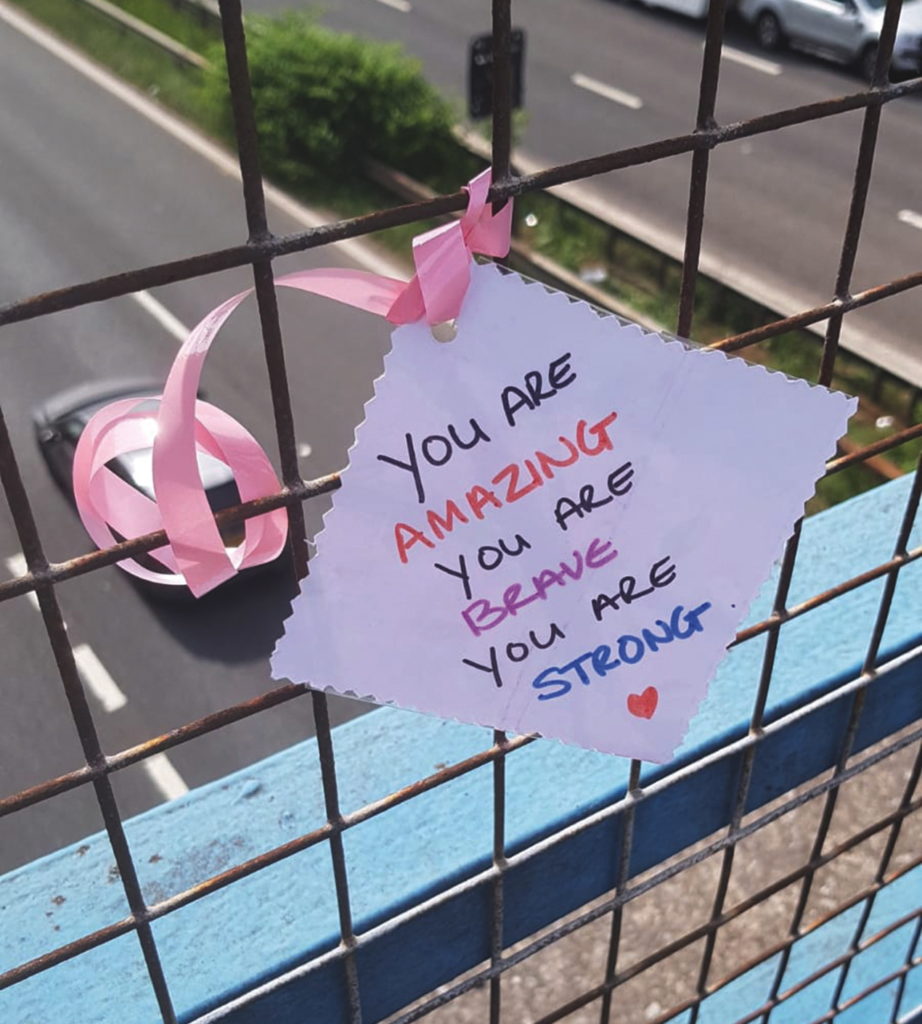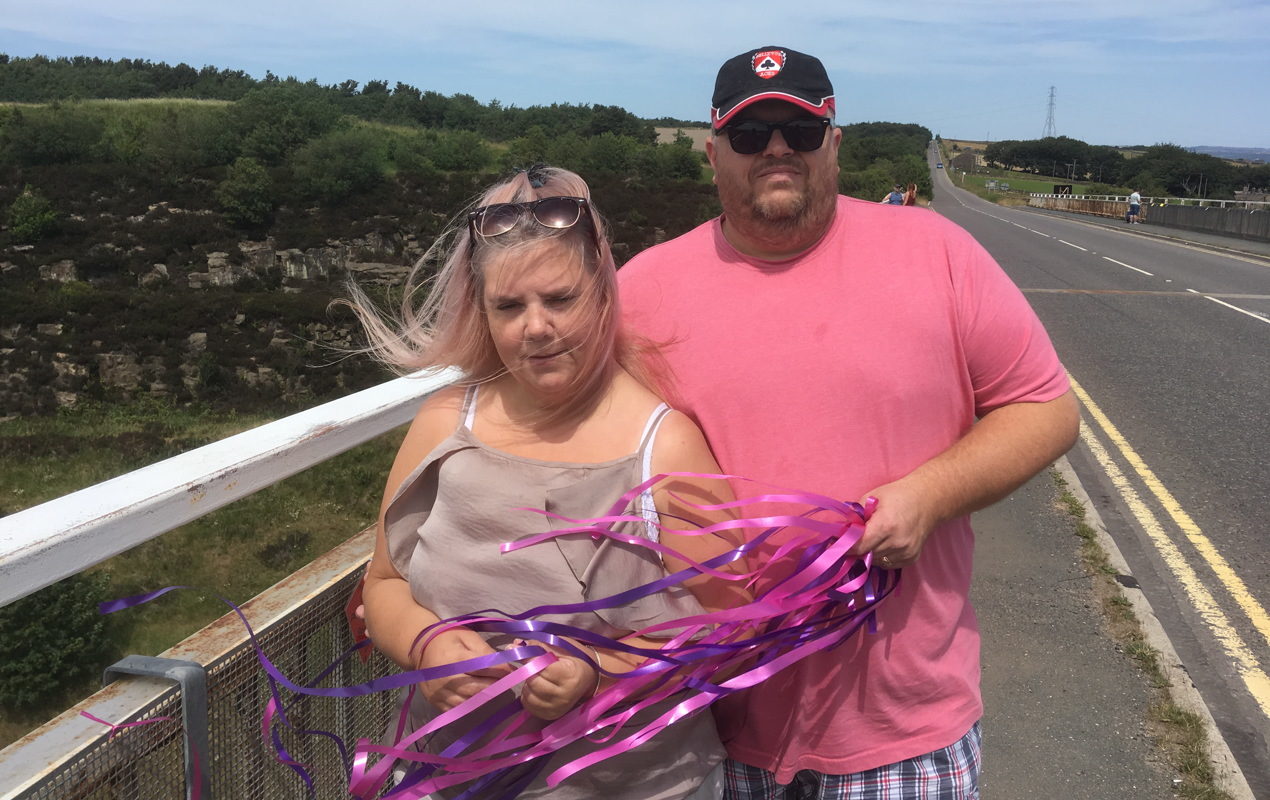Take notes
The handwritten notes of kindness that have appeared on bridges where people might be considering taking their own lives are meant only to do good. But do they go against expert guidelines?
I was in the process of carefully planning my own suicide when my mental health nurse noticed that I had gone rapidly downhill. She referred me to my local crisis team and with daily support and medication I was eventually helped out of the black hole that had previously felt inescapable.
That was just last summer when I wanted to end my own life to stop feeling the pain I did inside. Looking back, I don’t think I actually wanted to die but I could not see any other way out.
I have attempted suicide in the past and that time was more spontaneous than the last. It wasn’t thought through – it was impulsive.
There is no one size fits all when it comes to suicidal thoughts, feelings or actions. But on each occasion that I had intended to take my own life, I can now see that feeling and being suicidal is temporary.
Can a positive note left on a bridge really prevent people from taking their own lives?
One of the things that helps me to see a way through is to blog and vlog about my good days and my really bad. At the time I wrote: “I know suicide and self-harm seems so cruel, so thought out, so painful and so hurtful to you. But all I want to do is escape. I feel there is no hope. It isn’t always me wanting to harm myself – it is the voices in my head. Just as any physical disease can be cruel and unfair, so is mental illness. It is the only way I can cope right now. It is the only way I can think to get rid of this pain. I am not being rational or logical, so please don’t compare me to your thought processes. I am desperate and I hate putting you through this.”
Fortunately, as I am a journalist by trade, I have learnt that when reporting about suicide, even when blogging about my own suicidal thoughts and feelings, I have to be careful not to talk about the methods I use or would have used in order to follow reporting guidelines so that I do not trigger or highlight a method to other vulnerable people.
So I was intrigued by the phenomenon of notes on bridges. Can a positive note left on a bridge really prevent people from taking their own lives?
Like many people, I have shared viral videos on social media in which people have been attaching notes and ribbons to places that are seen as suicide hotspots.
And although I believe that the people doing this are trying to help others – and are probably vulnerable themselves – I started to worry whether actually this kind act of attaching lots of notes to hotspots could actually be highlighting a location and a method of suicide.
Samaritans reporting guidelines on suicide state: “Exercise caution when referring to the methods and context of a suicide. Details of suicide methods have been shown to prompt vulnerable individuals to imitate suicidal behaviour.”
They add: “Try not to illustrate a report with specific locations, such as a bridge or cliff, especially if this is a place where people frequently take their own lives.”
One could argue that decorating bridges with notes of support could be directing people to locations at their most vulnerable. But Lisa Barnes, who set up Bridge the Gap campaign, which decorates bridges with positive notes, believes the idea does work in saving people’s lives.
“We’ve decorated 31 bridges so far and we’ve saved at least 35 people that we know of. It definitely works,” says Barnes, who has been suicidal herself and believes she can understand what others are going through at that moment. She thinks the discreet signs Samaritans put up are not what you want in that moment.

She says: “The notes have to be from the heart and hand written. It’s the personal touch. You need something bright, cheerful and positive.”
Of her own suicide attempt, she says: “There were no signs. The day before I was fine and nobody would know anything was wrong.
“The next day I came into work and everything felt too much. I thought I would numb everything out. I took an overdose.”
Ten days after being let out of hospital, she tried to take her own life again but a police negotiator managed to talk her down. She says there was no mental health support after her first attempt.
“I thought my family would be better off if I wasn’t here. I’m lucky that I’m still here.”
It was this that spurred Barnes to do something to prevent others from taking their own lives. After learning mindfulness, she was inspired to write the notes as some of the quotes she had heard resonated with her.
“Suicide doesn’t take the pain away,” she says. “It just passes it to someone else. We just wanted to make someone pause by reading the notes so they could seek help.”
She says the police helped Bridge the Gap decorate the first bridge and the organisation has since “grown and grown”, with people and charities all over the country requesting for bridges to be decorated. She doesn’t believe the campaign could be highlighting places to vulnerable people.
“When you live in an area everyone knows the bridges people jump off. I know we’re not going to save everyone but we’ve had so many people read our messages.”
Mental Health First Aid England (MHFA) says that it’s important to remember there are other measures in place on these sites too. In the UK, Samaritans places signs on suicide spots offering the chance to talk, and local areas will often have Network Rail or police staff on site who are trained to help protect people.
Caroline Hounsell, director of communities and content development at MHFA England, says: “Anyone writing a note to try and prevent someone taking their own life will be doing so with good intentions… What is encouraging to see is that people are engaging with the subject of suicide and trying to help – it’s now in the public consciousness, which until recently wasn’t the case. The more we can talk about suicide, the less stigmatised it will become and the more we will be able to open up and learn together.
“It’s important to understand that one part of someone who is suicidal usually wants to live, and offering hope and reassurance can be really powerful in bringing this out. However, we also need to recognise and listen to the pain that person is feeling, refer them to further support, and help them get onto a path to recovery.
“We believe suicide is always preventable, and one of our goals is to help people to understand how to offer support on a first aid basis when someone is feeling suicidal.”
The handwritten notes may be thoughtful and from the heart but how do they affect someone in need? Do positive affirmations help? Examples include: “You’re amazing, you’re brave”; “You’ve got this”; and “If you were looking for a reason not to kill yourself, this is it.”
Kirsty Holden, who suffers from anxiety and depression, says: “I’m sure the notes would mean so much to so many, whether they read them or not. They are going to be seen blowing in the wind, which would hopefully draw someone who needs them to read them or at least make them aware someone cares.
“I think it stems from the fact I don’t ask for help, not because I don’t feel like I can but I struggle massively to put into words how I feel or why I sometimes feel the way I do. I just presume people know so those cards would help massively because there is bound to be something there that I want to subconsciously hear.
“I have suffered with anxiety since childhood but besides the transition from primary to secondary school and then school to work, where it affected me both mentally and physically, it was never really triggered again until I had children.
“What I’m told likely started as post-natal depression is still lingering now so to have someone tell me the things I need to hear at the time I need to hear it the most would mean the world.”
As someone who suffers from anxiety, depression and an acute polymorphic psychotic disorder, I struggle with positive statements and affirmations when I’m at my darkest mentally. When I am doing OK and managing I love positive quotes but when I struggle to cope I struggle to believe people care for me. So somebody who doesn’t know me online or offline telling me “You’re amazing” is nice but it won’t necessarily stop my spiral out of control. I remember when I received support from the crisis team whilst suffering from an eating disorder and them saying “but you’re so pretty, you’ve got so much to live for”, as if that would lessen the pain. It didn’t because when I am poorly I struggle to connect with reality.
I wrote: “Treat me like me. I am still me. Even if I seem a shell of my former (pre-breakdown) self, I am still me. I can’t find me right now. But I am still me. I am an individual.”
That said, I can really relate to Barnes, because I too was not given much aftercare following an overdose. You’d think if you had tried to take your own life that the services would act, but there wasn’t the resource. So it leaves the difficult task to altruistic people in our communities such as Barnes and maybe her notes would give me pause.
What can you do to help? Reach out to people in your community, either by signposting them to relevant services or activities, or offer your time with charities who help those in need and can help support you too. I wrote: “Don’t try to fix my illness. I am very poorly at the moment with death just a touch away. So it will be a long hard slog to rid me of this illness. It will be complicated but please just stand by me. You can’t fix me right now but you can stand by me.
“I am not thick. I am still a complex human being. You don’t need to belittle me or treat me like I am stupid. Even if I seem unable to respond or too sedated or manic to care, somewhere deep inside me I am still there. I have fought this far. Don’t give up on me yet.”
See samaritans.org and mhfaengland.org

Leave a reply
Your email address will not be published.